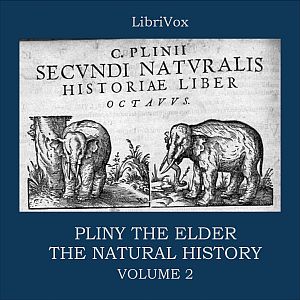- Science
- Nature
-
- general
- Family
- Physics & Mechanics
- Poetry
- Comedy
- Arts
- humor
- Music
- Exploration
- medieval
- contemporary
- Art
- ballads
- Erotica
- History
- Atheism & Agnosticism
- Essays
- Historical
- Design & Architecture
- Leisure
- Writing & Linguistics
- Health & Fitness
- True Crime
- Fiction
- Crafts & Hobbies
- Education
- Sports Fiction
- Letters
- Society & Culture
- Religious Fiction
- Elegies & Odes
- Family & Relationships
- Business & Economics
- Narratives
- Short non-fiction
- Travel Fiction
- Lyric
- Sports & Recreation
- Transportation
- religion
- Science
The Natural History Volume 2
by PLINY THE ELDER (23 - 79)40 - Book 10, Chapters 50-62: The acanthyllis and other birds; the merops - partidges; pigeons; wonderful things done by them; prices at which they have been sold; different modes of flight and progression in birds; the birds called apodes or cypseli; respecting the food of birds - the caprimulgus, the platea; the instinct of birds - the carduelis, the taurus, the anthus; birds which speak - the parrot; the pie which feeds on acorns; a sedition that arose among the Roman people in consequence of a raven speaking; the birds of Diomedes; animals that can learn nothing

Naturalis Historia (Latin for "Natural History") is an encyclopedia published circa AD 77-79 by Pliny the Elder. It is one of the largest single works to have survived from the Roman empire to the modern day and purports to cover the entire field of ancient knowledge, based on the best authorities available to Pliny. The work became a model for all later encyclopedias in terms of the breadth of subject matter examined, the need to reference original authors, and a comprehensive index list of the contents. The scheme of his great work is vast and comprehensive, being nothing short of an encyclopedia of learning and of art so far as they are connected with nature or draw their materials from nature. The work divides neatly into the organic world of plants and animals, and the realm of inorganic matter, although there are frequent digressions in each section. He is especially interested in not just describing the occurrence of plants, animals and insects, but also their exploitation (or abuse) by man, especially Romans. The description of metals and minerals is particularly detailed, and valuable for the history of science as being the most extensive compilation still available from the ancient world. (Summary from Wikipedia)This second volume includes books six to ten, covering the following subjects:Book 6 - An account of countries, nations, seas, towns, havens, mountains, rivers, distances, and peoples who now exist or formerly existedBook 7 - Man, his birth, his organization and the invention of the artsBook 8 - The nature of the terrestrial animalsBook 9 - The natural history of fishesBook 10 - The natural history of birds
Listen next episodes of The Natural History Volume 2:
41 - Book 10, Chapters 63-81: The mode of drinking with birds; the porphyrio; the haematopous; the food of birds; the pelican; foreign birds: the phalerides, the pheasant and the numidicae; the phoenicopterus, the attagen, the phalacrocorax, the pyrrhocorax and the lagopus; the new birds; the vipio; fabulous birds; who first invented the art of cramming poultry: why the first Censors forbade this practice; who first invented aviaries; the dish of Aesopus; the generation of birds: other oviparous animals; the various kinds of eggs and their nature; defects in brood-hens and their remedies; an augury derived from eggs by an empress; the best kinds of fowls; the diseases of fowls and their remedies; when birds lay and how many eggs; the various kinds of herons; what eggs are called hypenemia and what cynosura; how eggs are best kept; the only winged animal that is viviparous and nurtures its young with milk , 42 - Book 10, Chapters 82-98: Terrestrial animals that are oviparous; various kinds of serpents; generation of all kinds of terrestrial animals; the position of animals in the uterus; animals whose origin is still unknown; salamanders; animals which are born of beings that have not been born themselves - animals which are born themselves, but are not reproductive - animals which are of neither sex; the senses of animals - that all have the senses of touch and taste - those which are more remarkable for their sight, smell or hearing - moles - whether oysters have the sense of hearing; which fishes have the best hearing; which fishes have the finest sense of smell; diversities in the feeding of animals; animals which live on poisons; animals which live on earth - animals which will not die of hunger or thirst; diversities in the drinking of animals; antipathies of animals; proofs that they are sensible of frienship and other affections; instances of affection shown by serpents; the sleep of animals; what animals are subject to dreams;summary; Roman authors quoted; foreign authors quoted